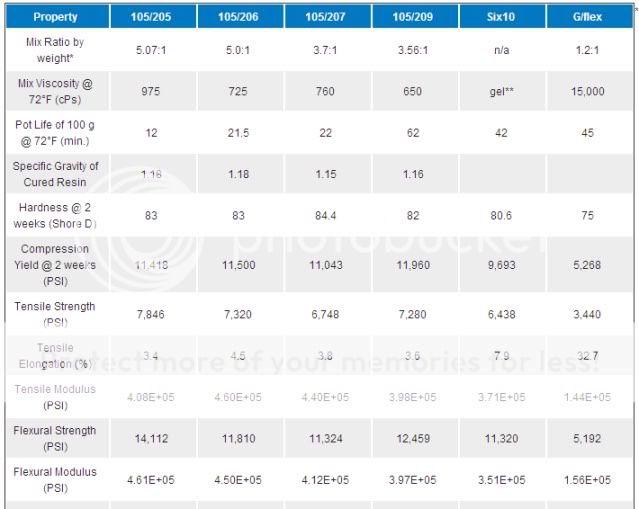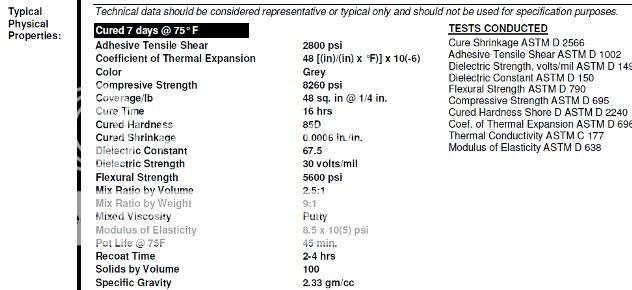Stocky
<strong>SPONSOR</STRONG>
The past few weeks I have had what you might consider to be an awakening in the world of epoxies as a result of my own endeavors to keep large fiberglass / plywood rockets from flying apart at supersonic velocities. This could all be somewhat irrelevant one could argue, as we have some great products available (i.e. Acraglas, Devcon, Marinetex, etc.) but allow me just a moment to encapsulate my findings and see if anyone has any thoughts.
I have no affiliation with anyone in the epoxy industry, just offering these discoveries as food for thought, perhaps as fodder to take this whole bedding thing to the next level.
Here's a few facts:
Since we are concerned with perfection as opposed to 'it's worked O.K. for 20 years why change' for the sake of this discussion, here's what the adhesion pros do outside the sporting arms industry. A great example would be some engine mounts in a yacht - we want them to fit the base of the motor perfectly, have the required adhesion to the structural components of the yacht and be able to take the pounding that a pair of turbo-diesels can dish out over a period of years. But they wouldn't want the engines permanently affixed, might have to pull them for service. Just a set of perfectly mated mounts with the mounts permanently mounted to the boat.
That ought to cover anything we'd dish out... for the purposes of this discussion we'll use West System 105 resin because it is available with a variety of hardeners to vary curing time as well as fillers to increase viscosity, it's a complete epoxy system. We need to make it thicker because it's not going to stay in place and make a good mold of the engine mounting bracket (barreled action) when it's in it's neat form - about like Karo syrup. (neat = no additives)
One example would be the West Systems 404 High-Density filler is designed just for that -
"404 High-Density filler is a thickening additive developed for maximum physical properties in hardware bonding where high-cyclic loads are anticipated. It can also be used for filleting and gap filling where maximum strength is necessary."
I doubt if I'd use that particular filler unless I needed to bed a really big boomer in a thin stock, but it is recommended for motor mounts so I'd think it can take it. Weatherproof too. There's fillers designed for body, strength, weight reduction, etc., seems to me that the something as flexible as this could be tailored to the conditions that the particular rifle would be subjected to.
Has anyone ever tried anything along these lines? What fillers have you experimented with?
Food for thought anyway ...
- Don
Research links:
Epoxy by the Leading Epoxy Manufacture | WEST SYSTEM Epoxy - West Systems Home
WEST SYSTEM | Use Guides - Education in the epoxy world
Aeropoxy Home - More great epoxies - I use 6029 & 2032 a lot
I have no affiliation with anyone in the epoxy industry, just offering these discoveries as food for thought, perhaps as fodder to take this whole bedding thing to the next level.
Here's a few facts:
- Epoxy does not mix chemically at a 1:1 ratio. More in the range of 3-5 resin to 1 hardener.
- Fillers are added to arrive at this convenient mixing figure.
- Gels and putties have such additives, that's why they are gels and putties.
- Such additives can easily be mixed in by the user to desired results.
- Epoxy cures to an inert plastic solid that sticks to nothing.
- Adhesion comes from a property called keying and results from the epoxy soaking into the material and hardening.
- Therefore, the thinner the epoxy and the longer it takes to cure, the more it soaks in.
Since we are concerned with perfection as opposed to 'it's worked O.K. for 20 years why change' for the sake of this discussion, here's what the adhesion pros do outside the sporting arms industry. A great example would be some engine mounts in a yacht - we want them to fit the base of the motor perfectly, have the required adhesion to the structural components of the yacht and be able to take the pounding that a pair of turbo-diesels can dish out over a period of years. But they wouldn't want the engines permanently affixed, might have to pull them for service. Just a set of perfectly mated mounts with the mounts permanently mounted to the boat.
That ought to cover anything we'd dish out... for the purposes of this discussion we'll use West System 105 resin because it is available with a variety of hardeners to vary curing time as well as fillers to increase viscosity, it's a complete epoxy system. We need to make it thicker because it's not going to stay in place and make a good mold of the engine mounting bracket (barreled action) when it's in it's neat form - about like Karo syrup. (neat = no additives)
- Start by degreasing and subsequently roughing up the area in question to increase the surface area of adhesion.
- Mix up some resin with the appropriate cure-time hardner 'neat'
- Thoroughly wet-out the area of the stock until the thin mixture saturates the material.
- Add the desired filler (fiberglass fibers, aluminum shavings, colloidal silica, etc.) to balance of mixture.
- Lay-in thickened mixture.
- Replace barreled action and finish as usual.
One example would be the West Systems 404 High-Density filler is designed just for that -
"404 High-Density filler is a thickening additive developed for maximum physical properties in hardware bonding where high-cyclic loads are anticipated. It can also be used for filleting and gap filling where maximum strength is necessary."
I doubt if I'd use that particular filler unless I needed to bed a really big boomer in a thin stock, but it is recommended for motor mounts so I'd think it can take it. Weatherproof too. There's fillers designed for body, strength, weight reduction, etc., seems to me that the something as flexible as this could be tailored to the conditions that the particular rifle would be subjected to.
Has anyone ever tried anything along these lines? What fillers have you experimented with?
Food for thought anyway ...
- Don
Research links:
Epoxy by the Leading Epoxy Manufacture | WEST SYSTEM Epoxy - West Systems Home
WEST SYSTEM | Use Guides - Education in the epoxy world
Aeropoxy Home - More great epoxies - I use 6029 & 2032 a lot
Last edited:


